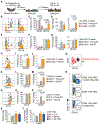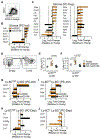Plasma Cells Are Obligate Effectors of Enhanced Myelopoiesis in Aging Bone Marrow
- PMID: 31303400
- PMCID: PMC6703913
- DOI: 10.1016/j.immuni.2019.06.006
Plasma Cells Are Obligate Effectors of Enhanced Myelopoiesis in Aging Bone Marrow
Abstract
Aging results in increased myelopoiesis, which is linked to the increased incidence of myeloid leukemias and production of myeloid-derived suppressor cells. Here, we examined the contribution of plasma cells (PCs) to age-related increases in myelopoiesis, as PCs exhibit immune regulatory function and sequester in bone marrow (BM). PC number was increased in old BM, and they exhibited high expression of genes encoding inflammatory cytokines and pathogen sensors. Antibody-mediated depletion of PCs from old mice reduced the number of myeloid-biased hematopoietic stem cells and mature myeloid cells to levels in young animals, but lymphopoiesis was not rejuvenated, indicating that redundant mechanisms inhibit that process. PCs also regulated the production of inflammatory factors from BM stromal cells, and disruption of the PC-stromal cell circuitry with inhibitors of the cytokines IL-1 and TNF-α attenuated myelopoiesis in old mice. Thus, the age-related increase in myelopoiesis is driven by an inflammatory network orchestrated by PCs.
Keywords: aging; hematopoiesis; inflammaging; inflammation; interleukin-1; lymphopoiesis; myelopoiesis; plasma cell; plasmablast; tumor necrosis factor.
Copyright © 2019 Elsevier Inc. All rights reserved.
Conflict of interest statement
Declaration of Interests
The authors declare no competing interests.
Figures







Comment in
-
Old plasma cell network supports the myeloid lineage.Nat Rev Immunol. 2019 Sep;19(9):534-535. doi: 10.1038/s41577-019-0205-9. Nat Rev Immunol. 2019. PMID: 31337879 No abstract available.
Similar articles
-
Promotion of Expansion and Differentiation of Hematopoietic Stem Cells by Interleukin-27 into Myeloid Progenitors to Control Infection in Emergency Myelopoiesis.PLoS Pathog. 2016 Mar 18;12(3):e1005507. doi: 10.1371/journal.ppat.1005507. eCollection 2016 Mar. PLoS Pathog. 2016. PMID: 26991425 Free PMC article.
-
Lipopolysaccharide reciprocally alters the stromal cell-regulated positive and negative balance between myelopoiesis and B lymphopoiesis in C57BL/6 mice.Biol Pharm Bull. 2014;37(12):1872-81. doi: 10.1248/bpb.b14-00279. Biol Pharm Bull. 2014. PMID: 25451836
-
Inflammatory biomarker, neopterin, suppresses B lymphopoiesis for possible facilitation of granulocyte responses, which is severely altered in age-related stromal-cell-impaired mice, SCI/SAM.Exp Biol Med (Maywood). 2007 Jan;232(1):134-45. Exp Biol Med (Maywood). 2007. PMID: 17202594
-
Marrow Adiposity and Hematopoiesis in Aging and Obesity: Exercise as an Intervention.Curr Osteoporos Rep. 2018 Apr;16(2):105-115. doi: 10.1007/s11914-018-0424-1. Curr Osteoporos Rep. 2018. PMID: 29476393 Free PMC article. Review.
-
Sensing and translation of pathogen signals into demand-adapted myelopoiesis.Curr Opin Hematol. 2016 Jan;23(1):5-10. doi: 10.1097/MOH.0000000000000201. Curr Opin Hematol. 2016. PMID: 26554891 Review.
Cited by
-
Systemic and local regulation of hematopoietic homeostasis in health and disease.Nat Cardiovasc Res. 2024 Jun;3(6):651-665. doi: 10.1038/s44161-024-00482-4. Epub 2024 Jun 12. Nat Cardiovasc Res. 2024. PMID: 39196230 Review.
-
Inflammation as a regulator of hematopoietic stem cell function in disease, aging, and clonal selection.J Exp Med. 2021 Jul 5;218(7):e20201541. doi: 10.1084/jem.20201541. Epub 2021 Jun 15. J Exp Med. 2021. PMID: 34129016 Free PMC article. Review.
-
Aging and Clonal Behavior of Hematopoietic Stem Cells.Int J Mol Sci. 2022 Feb 9;23(4):1948. doi: 10.3390/ijms23041948. Int J Mol Sci. 2022. PMID: 35216063 Free PMC article. Review.
-
Unraveling Heterogeneity in the Aging Hematopoietic Stem Cell Compartment: An Insight From Single-cell Approaches.Hemasphere. 2023 May 26;7(6):e895. doi: 10.1097/HS9.0000000000000895. eCollection 2023 Jun. Hemasphere. 2023. PMID: 37304939 Free PMC article. Review.
-
Age-Related Dynamics of Lung-Resident Memory CD8+ T Cells in the Age of COVID-19.Front Immunol. 2021 Mar 29;12:636118. doi: 10.3389/fimmu.2021.636118. eCollection 2021. Front Immunol. 2021. PMID: 33854506 Free PMC article. Review.
References
-
- Beerman I, Bhattacharya D, Zandi S, Sigvardsson M, Weissman IL, Bryder D, and Rossi DJ (2010). Functionally distinct hematopoietic stem cells modulate hematopoietic lineage potential during aging by a mechanism of clonal expansion. Proceedings of the National Academy of Sciences of the United States of America 107, 5465–5470. - PMC - PubMed
-
- Benz C, Copley MR, Kent DG, Wohrer S, Cortes A, Aghaeepour N, Ma E, Mader H, Rowe K, Day C, et al. (2012). Hematopoietic stem cell subtypes expand differentially during development and display distinct lymphopoietic programs. Cell stem cell 10, 273–283. - PubMed
Publication types
MeSH terms
Substances
Grants and funding
LinkOut - more resources
Full Text Sources
Medical
Molecular Biology Databases

